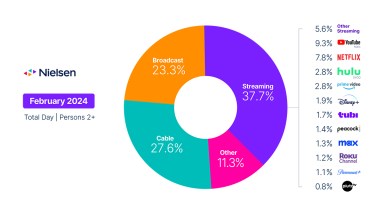When people around the world retreated to their homes as the COVID-19 pandemic set in early this year, we knew that video consumption, particularly TV usage, would spike. But at the same time, we knew that consumption would gradually return to seasonal averages. Seeing that consumption rise and then normalize during the workday, however, was somewhat unexpected, particularly among remote professionals and managers. But that is the new media consumption reality.
In August, many consumers in the U.S. were still adjusting to working remotely. That adjustment involved complementing their workdays with video content, as 65% of respondents in a Nielsen Remote Workers survey said they watched TV or streamed video content during their work breaks. In other cases, video became a work companion, as 56% of respondents said they watched TV or streamed video content with sound (50% did so without sound) while they were actively working.
Now, after living in a pandemic for nine months, daytime has become a second primetime for total TV consumption among many former office professionals and managers. On average, these workers increased their total TV time (live, time-shifted, internet-connected device, game console) by 21% between 9 a.m. and 4 p.m in October 2020. Among professionals, that increase equates to 26 additional minutes per day. During a typical work week (9 a.m.-4 p.m. M-F) , professionals are engaging with TV two hours and 10 minutes more than they were a year ago. Importantly, the uptick in daytime consumption has not negatively affected evening viewing. In fact, these same viewers increased their usage between 5 p.m. and 8 p.m. as well.
While overall media usage in the U.S. did normalize following the peaks brought on by the initial shelter-in-place restrictions, the strength of the streaming market and consumers’ appetite for content has forever tipped the share of consumption—a trend that has very much materialized during the workday—and not just among remote workers.
Unlike video game console and DVD usage, daytime internet-connected device usage has increased by significant double-digits among all age groups and all worker/non-worker groups. Among professionals, increased internet-connected device tracks throughout the day, whereas engagement among kids has increased in more of a bell shape, with the biggest increases appearing around lunchtime. That bell curve, however, includes some hefty increases in total TV usage during typical school hours: 50 minutes per week among kids 2-5; 3 hours 25 minutes among kids 6-11; and two hours among kids 12-17.
The implications of the shifting behavior for networks, advertisers and agencies are significant for two primary reasons: engagement timing and audience spending power.
It goes without saying that networks, programmers and advertisers aim to reach specific audiences. Today, the time to reach those audiences is different than it was back in January. That means content creators, networks and marketers should be actively thinking about making adjustments to ensure that their efforts are seen and heard when engagement is high. Additionally, given the economic implications of the pandemic, not all consumers have the financial wherewithal to spend freely. Across consumer groups, professionals and managers are more likely to be insulated to some degree, and they typically live in higher-earning households than non-professionals.
The focus shouldn’t all fall on professionals, however. Kids under 18 have also spent the past nine months adjusting, and they have now established new daily routines that involve significantly more time with TV than last year. For example, total TV usage in October 2020 between 9 a.m and 4 p.m. was 41% and 56% higher among kids 12-17 and 6-11, respectively, than it was in October 2019. And with much of that engagement coming from internet-connected devices and game consoles, it’s a safe bet that their households are worthy of heightened daytime brand engagement.
With many children across the country participating in remote learning, at least part of the week, increased media use during the day should be somewhat expected—but perhaps not to the degree we’re seeing among kids 6-11 (82% higher at 11 a.m.). Interestingly, the increases aren’t solely attributable to internet-connected devices and video game console usage. While those options are dominant daytime diversions, 6-11 and 12-17 year-olds are spending double-digit increases in time watching live/time-shifted television and watching DVDs.
According to a 2009 study conducted by Phillippa Lally published in the European Journal of Social Psychology, it takes an average of 66 days before a new behavior becomes automatic and routine. Today, we are well past this time frame, which has significant implications for pre-COVID behaviors.
If we view these findings through a media lens, Americans who have been working from home for the bulk of 2020 have had more than enough time to settle into their new TV usage routines. In looking at the rise in COVID-19 cases in recent weeks, as well as the new restrictions being put in place in various metro areas across the country, networks, programmers and advertisers should be maximizing the increased exposure that key audiences have throughout the day with the TV glass. The established new routines of consumers, the colder winter months and increased movement restrictions will further solidify daytime TV as a true work companion.



